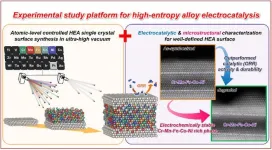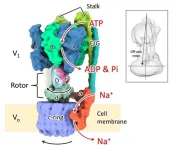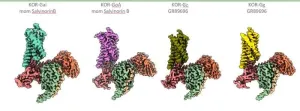(Press-News.org) New Alzheimer’s research from UVA Health suggests that enhanced light sensitivity may contribute to “sundowning” – the worsening of symptoms late in the day – and spur sleep disruptions thought to contribute to the disease’s progression.
The new insights into the disruptions of the biological clock seen in Alzheimer’s could have important potential both for the development of treatments and for symptom management, the researchers say. For example, caregivers often struggle with the erratic sleep patterns caused by Alzheimer’s patients’ altered “circadian rhythms,” as the body’s natural daily cycle is known. Light therapy, the new research suggests, might be an effective tool to help manage that.
Further, better understanding Alzheimer’s effects on the biological clock could have implications for preventing the disease. Poor sleep quality in adulthood is a risk factor for Alzheimer’s, as our brains, at rest, naturally cleanse themselves of amyloid beta proteins that are thought to form harmful tangles in Alzheimer’s.
“Circadian disruptions have been recognized in Alzheimer's disease for a long time, but we've never had a very good understanding of what causes them,” said researcher Thaddeus Weigel, a graduate student working with Heather Ferris, MD, PhD, of the University of Virginia School of Medicine’s Division of Endocrinology and Metabolism. “This research points to changes in light sensitivity as a new, interesting possible explanation for some of those circadian symptoms.”
Alzheimer’s is the most common form of dementia, affecting 50 million people around the world. Its hallmark is progressive memory loss, to the point that patients can forget their own loved ones, but there can be many other symptoms, such as restlessness, aggression, poor judgment and endless searching. These symptoms often worsen in the evening and at night.
Ferris and her collaborators used a mouse model of Alzheimer’s to better understand what happens to the biological clock in Alzheimer’s disease. They essentially gave the mice “jet lag” by altering their exposure to light, then examined how it affected their behavior. The Alzheimer’s mice reacted very differently than did regular mice.
The Alzheimer’s mice, the scientists found, adapted to a six-hour time change significantly more quickly than the control mice. This, the scientists suspect, is the result of a heightened sensitivity to changes in light. While our biological clocks normally take cues from light, this adjustment happens gradually – thus, jet lag when we travel great distances. Our bodies need time to adapt. But for the Alzheimer’s mice, this change happened abnormally fast.
The researchers initially thought this might be because of inflammation in the brain – “neuroinflammation.” So they looked at immune cells called microglia that have become promising targets in our efforts to develop better Alzheimer’s treatments. But the scientists ultimately ruled out this hypothesis, determining that microglia did not make a difference in how quickly mice adapted. (That’s not to say that targeting microglia won’t be beneficial for other reasons.)
Notably, the UVA scientists also ruled out another potential culprit: “mutant tau,” an abnormal protein that forms tangles in the Alzheimer’s brain. The presence of these tangles also did not make a difference in how the mice adapted.
The researchers’ results ultimately suggest there is an important role for the retina in the enhanced light sensitivity in Alzheimer’s, and that gives researchers a promising avenue to pursue as they work to develop new ways to treat, manage and prevent the disease.
“These data suggest that controlling the kind of light and the timing of the light could be key to reducing circadian disruptions in Alzheimer’s disease,” Ferris said. “We hope that this research will help us to develop light therapies that people can use to reduce the progression of Alzheimer’s disease.”
The researchers have published their findings in the scientific journal Frontiers in Aging Neuroscience. The research team consisted of Weigel, Cherry L. Guo, Ali D. Güler and Ferris. The team members have no financial interest in the work.
The research was supported by the National Institutes of Health, grants K08DK097293, T32GM139787 and R35 GM140854; the Owens Family Foundation; and the Commonwealth of Virginia’s Alzheimer’s and Related Diseases Research Fund.
To keep up with the latest medical research news from UVA, subscribe to the Making of Medicine blog.
END
Enhanced light sensitivity may contribute to Alzheimer's 'sundowning,' disease progression
Light therapy may help, new research suggests
2023-07-28
ELSE PRESS RELEASES FROM THIS DATE:
Researchers reveal a powerful platform for studying high-entropy alloy electrocatalysis
2023-07-28
Introduced in 2004, high-entropy alloys (HEAs) are alloys composed of multiple principal elements in nearly equiatomic proportions. Their unique chemical composition results in a high degree of chemical disorder, i.e. entropy, and produces remarkable properties such as high strength, ductility, and strong wear-and-tear resistance even at high temperatures. Scientists have dedicated a significant amount of attention to developing novel HEAs to help improve the performance of various electrocatalyst materials.
Because they are made up of differing constituent elements, HEAs' atomic-level surface designs can be complex. But unravelling this complexity is crucial, since the surface ...
San Diego family shares recent tragedy of losing daughter to necrotizing enterocolitis, as NEC Society prepares for the NEC Symposium in San Diego
2023-07-28
San Diego, CA - The NEC Society and Cincinnati Children’s have teamed up to present the NEC Symposium, the only conference in North America dedicated to understanding and preventing necrotizing enterocolitis (NEC). NEC is a devastating intestinal disease that affects medically fragile infants in their first weeks and months of life. Every year in the United States, thousands of babies are diagnosed with NEC and at least one baby dies from NEC every day. The NEC Symposium will transform the NEC Research ...
Citizen science inspires kids to take local action
2023-07-28
North Carolina State University researchers recently found that a program designed to get Girl Scouts involved in citizen science – programs where members of the public can participate in real scientific research – not only taught girls about the process of science, but also motivated them to tackle scientific or environmental problems in their communities.
The findings demonstrate the impacts citizen science projects can have on their participants and offer lessons for other organizations on how to structure STEM-focused learning opportunities using citizen science.
“We’ve found that after participating ...
The structures of six states of a rotary sodium ion pump are revealed
2023-07-28
Six structures exhibited by the rotating sodium ion pump were reconstructed in 3D using cryo-electron microscopy. This analysis revealed that (1) the rotor exhibits non-uniform rotation behavior due to partial structural interference with the stator component, and (2) the rotor interacts with one edge of the large ion transport ring causing it to rotate. The study showed a unique molecular mechanism of the rotary sodium ion pump.
The results will be published on July 28 in Communications Biology.
“In previous single-molecule imaging ...
New research highlights risks of selective adaptation in extreme coral habitats
2023-07-28
Resilient corals, often referred to as ‘super corals’, have recently been seen as potential saviours in the face of climate change and its detrimental effects on coral reefs.
Now, a team of scientists from the University of Technology Sydney (UTS) and the University of Haifa, Israel is working to better understand these corals in order to develop strategies to protect fragile ecosystems such as the Great Barrier Reef.
UTS scientist Dr Emma Camp, co-lead researcher on the study recently published in the journal Nature Communications, says the findings have significant implications ...
What nap times reveal about your child’s brain development
2023-07-28
Infants who nap a lot have smaller vocabularies and poorer cognitive skills – according to new research from the University of East Anglia.
Parents the world over are prone to worry about their children getting either too little or too much sleep.
But a new study published today reveals that some children are more efficient at consolidating information during sleep, so they nap less frequently.
Meanwhile others, usually those with fewer words and poorer cognitive skills, need to nap more frequently.
The research team say that reducing naps for these children will not improve brain development, ...
Activewear angst: Why shopping for workout clothes can be harmful to women
2023-07-28
Though it’s just as likely to be worn while lounging on the couch as in the gym, a large driver of activewear’s popularity among women is its association with a dynamic lifestyle, positive wellbeing and overall good health.
However, two new Edith Cowan University (ECU) studies suggest online shopping for activewear may in fact be harmful to women’s body image.
Sales of “Athleisure” — a hybrid style of athletic clothing typically worn as everyday wear — have risen rapidly following ...
This 3D printed gripper doesn’t need electronics to function
2023-07-28
This soft robotic gripper is not only 3D printed in one print, it also doesn’t need any electronics to work.
The device was developed by a team of roboticists at the University of California San Diego, in collaboration with researchers at the BASF corporation, who detailed their work in a recent issue of Science Robotics.
The researchers wanted to design a soft gripper that would be ready to use right as it comes off the 3D printer, equipped with built in gravity and touch sensors. As a result, the gripper can pick up, hold, and release objects. No such gripper existed before this work.
“We ...
Structure of opioid receptors may reveal how to better design pain relievers, addiction therapies
2023-07-28
Opioids remain the most potent and effective pain relievers in medicine, but they’re also among the most addictive drugs that can halt a person’s ability to breathe during an overdose — which can be deadly. Researchers have been racing to develop safer pain reliever drugs that target a specific opioid receptor, called the kappa opioid receptor, that is only found in the central nervous system and not elsewhere in the body, like other opioid receptors. Previous research suggests that such drugs may not lead to addiction or death due to overdose, but ...
Osivax announces publication in The Lancet Infectious Diseases of Phase 2a data for broad-spectrum influenza vaccine candidate, OVX836
2023-07-28
OVX836 demonstrated positive safety and immunogenicity data across three dose levels
A notable signal of protection of 84% was observed against symptomatic influenza infection
Lyon, France – July 28, 2023 – Osivax, a biopharmaceutical company developing vaccines to provide broad-spectrum protection against highly mutating infectious viruses, today announced that The Lancet Infectious Diseases published results from the company’s OVX836-003 study under the title, “Immunogenicity, safety and preliminary efficacy evaluation of OVX836, a nucleoprotein-based universal influenza A vaccine candidate: randomised, double-blind placebo-controlled, Phase 2a trial.” ...
LAST 30 PRESS RELEASES:
Kennesaw State University’s Jerry Mack named Paul “Bear” Bryant Newcomer Coach of the Year
Ancient teeth are treasure troves of data on Iron Age lifestyles
Avocados may become easier to grow in India—but not if global emissions remain high
Pregnant women with IBD show heightened inflammation in vaginal mucosa
Underwater photos show seabirds, seals and fish interacting with a tidal turbine in Washington State
1 in 5 surveyed UK adults who have experienced the death of a pet report it as more distressing than experienced human deaths, with significant rates of prolonged grief disorder symptoms also being re
Polyester microfibers in soil negatively impact the development of cherry tomato plants in experiments, raising concerns over the potential effect of high levels of such contaminants
LGBTQ+ adults may be around twice as likely to be unemployed or to report workforce non-participation compared to heterosexual adults, per large representative Australian survey
Horses can smell fear: In experiments where horses smelled sweat from scared humans, they reacted to scary and sudden events with increased fear and reduced human interaction
New synaptic formation in adolescence challenges conventional views of brain development
Scientists identify target to treat devastating brain disease
Oliver Zielinski selected as Fellow of The Oceanography Society
Has progress stalled on gender equality at work?
Quantum simulator sheds light on how nature moves energy in systems like photosynthesis and solar conversion
Can a hashtag help prevent atrocities? Study shows social media can be a powerful tool
The American Ornithological Society (AOS) announces the winner of the 2025 Wesley Lanyon Award
Woolly rhino genome recovered from Ice Age wolf stomach
An earthquake on a chip: New tech could make smartphones smaller, faster
New research shows how AI tools are expanding individual capabilities while contracting scientific attention
A nanomaterial flex — MXene electrodes help OLED display technology shine, while bending and stretching
Global research team uncovers mechanism by which metabolites guide cellular decisions
Work hours, stress, and burnout among resident physicians
Quality of life of parents of premature infants
Should younger and older people receive different treatments for the same infection?
Scientists discover how fast the world’s deltas are sinking
Scientists demonstrate first-time use of AI for genetic circuit design
Copenhagen researchers make the front page of Nature: Solving the mystery of the universe's ‘little red dots’
Seoul National University-Drexel University team achieves world's highest efficiency fully stretchable OLEDs with 17% external quantum efficiency
Hydrogel cilia set new standard in microrobotics
Application of orthogonal CNOP-I in a convection-allowing ensemble prediction system based on CMA-MESO for improving extreme precipitation skill
[Press-News.org] Enhanced light sensitivity may contribute to Alzheimer's 'sundowning,' disease progressionLight therapy may help, new research suggests







